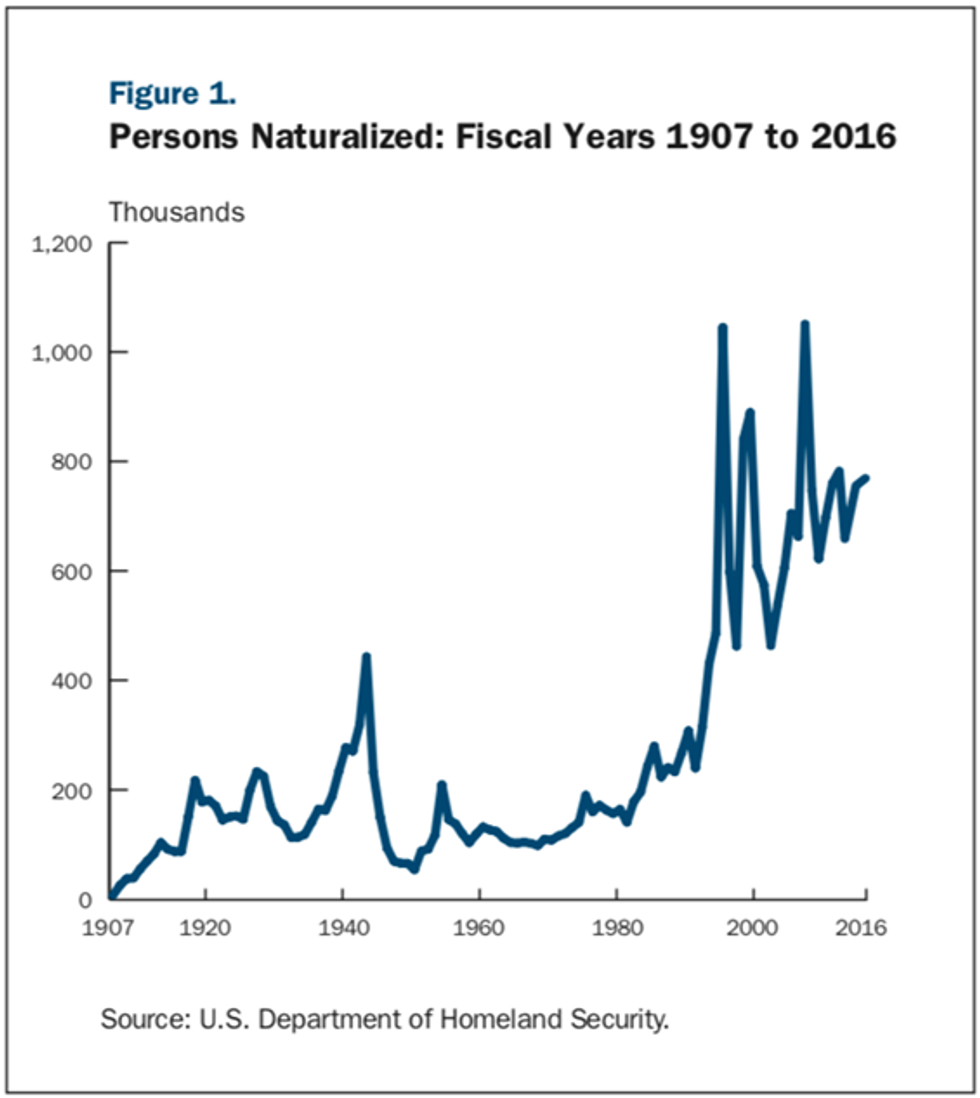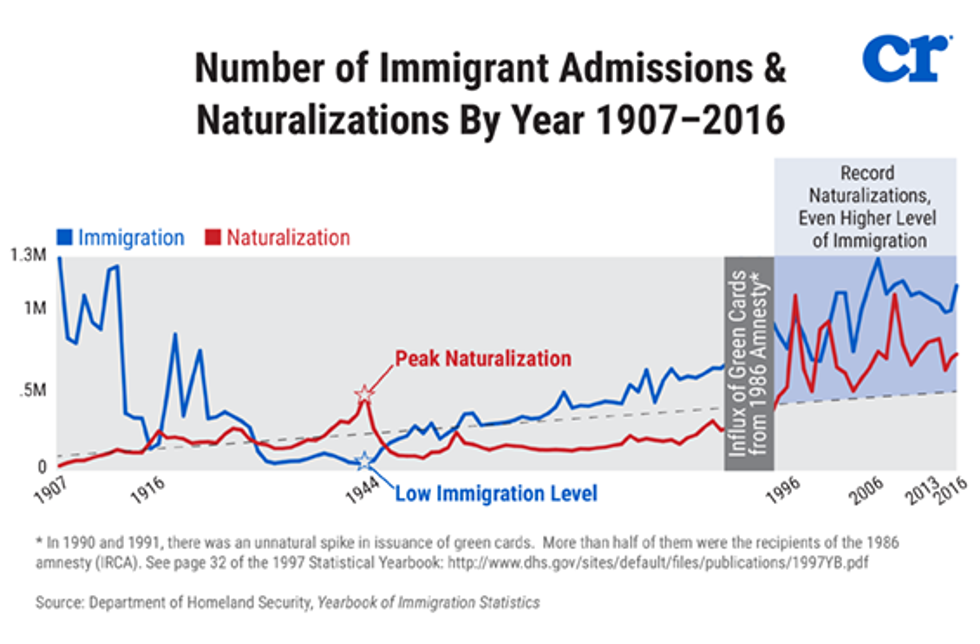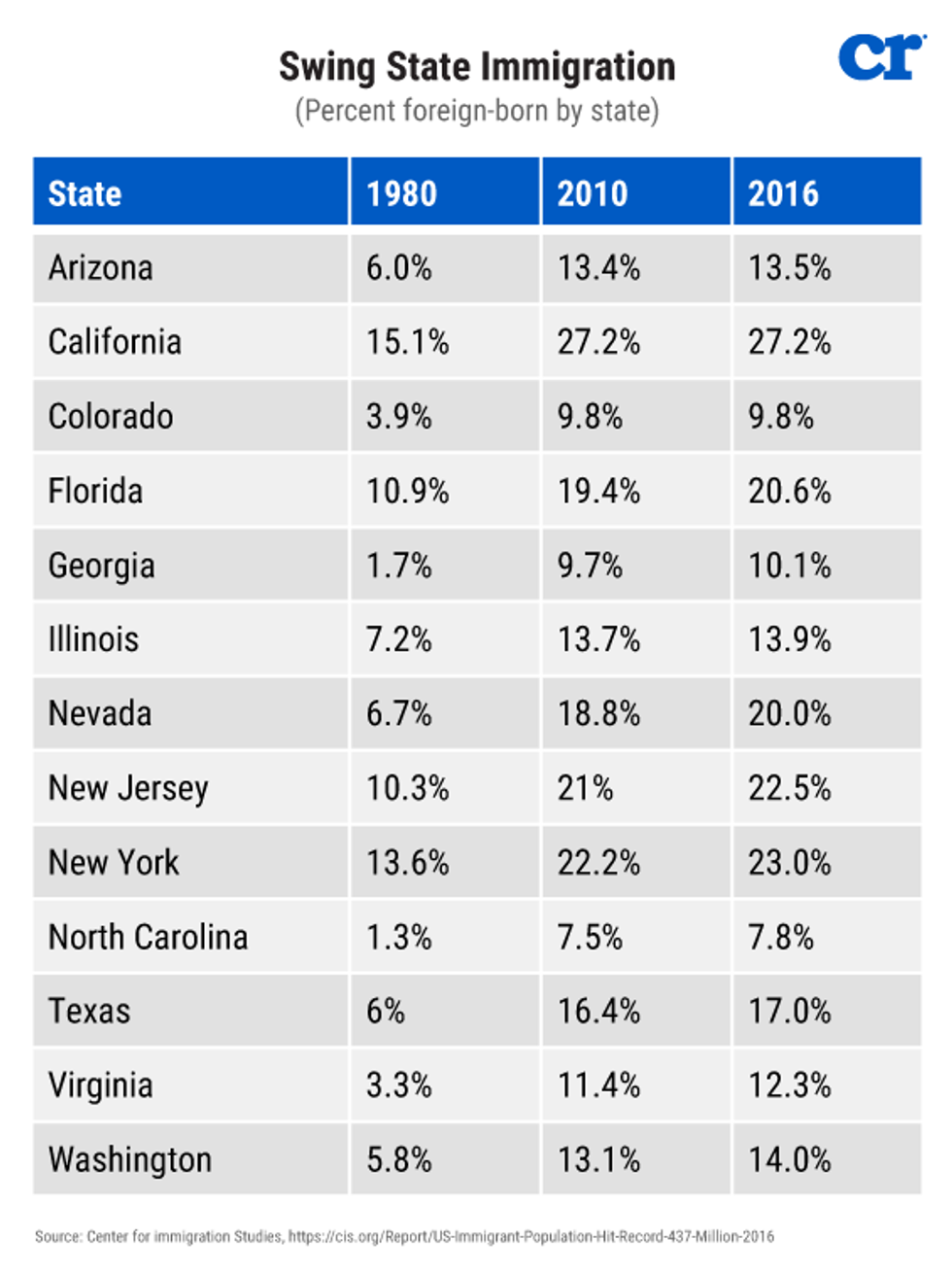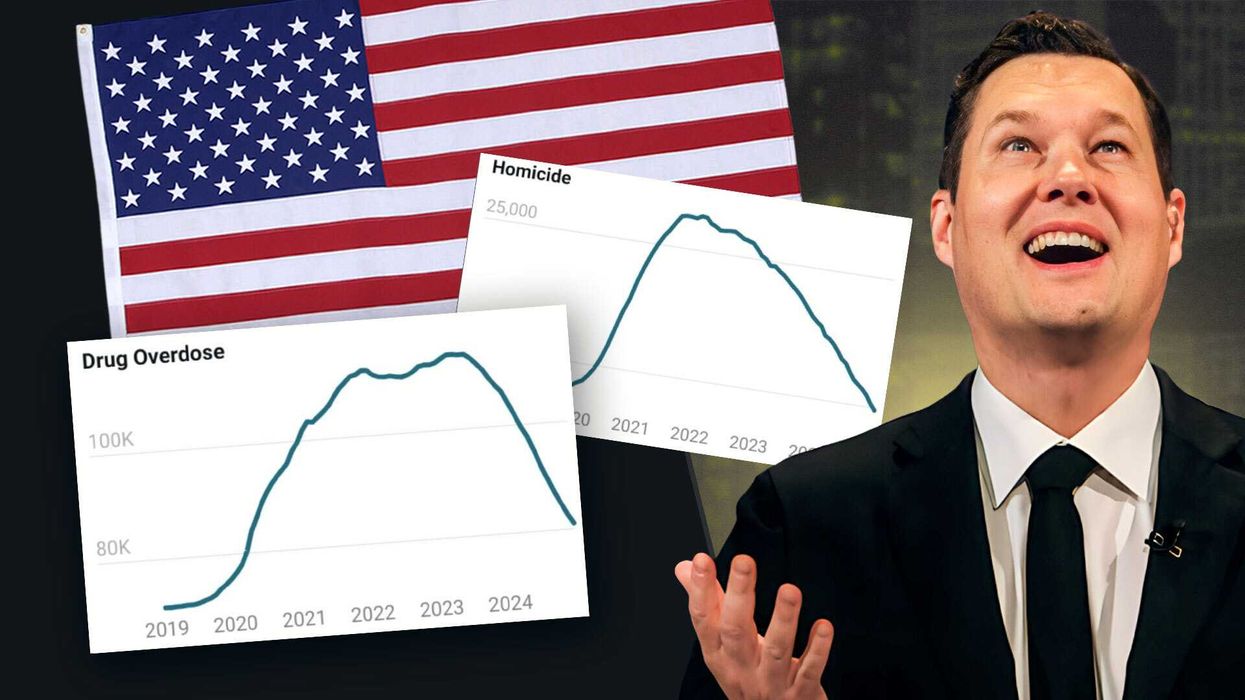
© 2025 Blaze Media LLC. All rights reserved.
Our Founders were very clear that they intended naturalization to be controlled by the federal government instead of by the states, as it had been under the Articles of Confederation, because they wanted stricter standards, not looser standards. While there were several motivations for this principle, the overarching reason was that they wanted to ensure the voting populace would consist of those who shared our democratic-republican values.
Even though immigrants back then were all from the same European stock as the current Americans, Theodore Sedgewick said during the debate on the 1790 naturalization bill that “their sensations, impregnated with prejudices of education, acquired under monarchical and aristocratical Governments, may deprive them of that zest for pure republicanism, which is necessary in order to taste its beneficence with that gratitude which we feel on the occasion.” Madison spoke of admitting only those “who are attached to our Country by its natural and political advantages.”
Jefferson feared they would “bring with them the principles of the governments they leave, imbibed in their early youth…These principles, with their language, they will transmit to their children. In proportion to their numbers, they will share with us the legislation. They will infuse into it their spirit, warp and bias its direction, and render it a heterogeneous, incoherent, distracted mass.”
The solution to this problem is having a gradual and balanced immigration system based on merit and shared values. Instead, the endless cycles of illegal immigration, amnesties, and back-door amnesty-style programs (asylum, temporary protected status, refugees), in conjunction with chain migration, has made our immigration system work for foreigners, not for citizens, realizing the worst nightmares of our founders.
Look no further than California to understand how immigration done wrong can lead to a permanent majority of anti-life, pro-big-government Democrats. The problem is that many other states are headed down the same path, in a slower but inexorable trajectory. If the same policies continue, if chain migration is not immediately halted, conservatives will find themselves in the minority nationwide, and no other issue will matter. Even though the Republican Party is not conservative, it is perceived as such and should take heed of the obvious warning signs.
No, this is not like the great immigration wave of the last century
There has been a lot of focus in recent years on the number of green cards issued each year, but not on the number of people becoming citizens. Over the past 20 years, the U.S. has admitted roughly 700,000-800,000 citizens into our voting population every year, with a few years reaching one million. Most of them have come from countries with dramatically different worldviews on issues such as guns, health care, and the size of government. Many deniers within the GOP of the political problems of mass migration point to past history and saying our previous large wave of immigration didn’t create a permanent liberal majority. But that is because we are now dwarfing the previous great wave in numbers.
Even during the highest naturalization years of the great wave, we admitted anywhere from 100,000 to 250,000 new citizens to our electorate. In other words, even during the great wave, when there were some years we admitted roughly as many annual immigrants as we do today, that era of immigration didn’t result in as many people becoming citizens. Some of this had to do with life expectancy, but either way, the wave didn’t result in nearly as many naturalizations. And even the peak period of naturalization was not only much smaller but only lasted for a short period of time.
From 1996 to 2013, 12,609,174 new immigrants became citizens. During the actual great wave, the number of naturalizations was still very low because it took time for them to go through the system and become citizens. But even if you take an equivalent 18-year period with the highest level of naturalizations, which was from 1928 to1945, just 3,835,758 immigrants were naturalized. In other words, while the immigration wave of the modern era was 66 percent larger than the great wave, the “naturalization wave” was 329 percent greater.
Moreover, we have not even actualized the full extent of this wave of immigration, which is still growing.
Finally, let’s not forget that because of the shutoff in the ’20s, the peak of naturalizations resulting from the great wave coincided with a cool-off in new immigration. Contrast that to today’s wave of naturalizations that are coinciding with an even larger wave of new admissions from similar areas. This ensures a lack of assimilation into our constitutional values. Although immigrants have always voted for more liberal politicians, enough of them were moving on to the second generation and becoming conservatives. The ’30s and ’40s, when the highest numbers of great wave immigrants were becoming voting members of society, was the lowest of our new immigration levels. As noted immigration historian Maldwyn Allen Jones observed, “With reinforcements no longer arriving from across the ocean, ties with Europe were gradually weakened and memories of the old life grew dimmer with each passing year.” This dynamic “accelerated the Americanization of those groups which had come earlier.”
That is changing because the numbers are too great, the welfare state too expansive, and the immigrants dramatically and disproportionately coming from impoverished lands.
Painting the map blue
Let’s explore the results of this wave as it relates to critical states electorally, and you will see why it is so hard for Republicans to crack the blue firewall. This is somewhat old data, and the trajectory is growing every year:
What is self-evident from this data is not only the danger of Republicans losing places like Texas, Florida, and Arizona. It’s not only an explanation of why Republicans lost Virginia, Colorado, and Nevada. It also foreshadows what will happen to North Carolina, Georgia, and beyond. As late as 1990, the foreign-born population of Virginia was just five percent. It swelled to 11.4 percent in 2010 and is still surging, as high as 12.3 percent in 2016. While Virginia has experienced an influx of already-American liberals over the past two decades, that would only explain why it’s a marginal red state or even a purple state, not why it’s become a blue state.
Now take a look at the numbers and recent trajectory from Georgia. Again, there is an influx of American white liberals from other states as well as a general increase in black turnout. But immigration is what is going to paint those states purple.
Trump talks about shutting off chain migration 10 to 15 years from now, but the reality is that just the existing trajectory will paint the map blue.
While not every state will become as blue as California, the lessons of the Golden State should be a stark warning for what happens with salad-bowl rather than melting-pot immigration. Orange County, California, was once the bread basket of GOP dominance in California. As late as 1988, George H.W. Bush won more than twice as many votes as Democrat Michael Dukakis there. As late as 2004, when the broader state was long gone, George W. Bush won it by 20 points. Republicans narrowly carried it for the next two elections, until they downright lost it by 8 points in 2016.
What happened? In 1980, 12.7 percent of the county was foreign-born. In 2016, an estimated 30 percent of the county was foreign-born, and 45.6 percent of its residents speak a foreign language at home. Orange County, California, will now be blue forever.
Although California is lost forever, Texas and Florida are both independently vital to the GOP’s relevance. Dallas County, Texas, for example, has gone from 5 percent foreign-born in 1980 to 23 percent in 2016. Reagan won the county by 59.2 percent in 1980, while Trump lost it by a whopping 26 points in 2016. Sure, some of this has to do with Trump’s particular weakness with some college-educated urban/suburban white voters, and he has compensated for it by running up margins elsewhere. But the influx of unprecedented immigration has gradually and relentlessly shifted a number of counties to the Democrats over the past few elections.
One cannot escape the conclusion that unless there is a cool-off on overall immigration, the unprecedented size and duration of this wave, constantly reinforcing itself, will ensure that there are not enough second-generation voters assimilating into constitutional values to offset the new influx voting for big government. This is a clear distinction from past waves of immigration.
Of course, conservatives need to reach out to all new voters from all parts of the world to sell their message. But numbers and time matter greatly. Constitutional values can be sold to a melting pot of Americans; it will not resonate with a salad bowl.
The bottom line is this: There are many good policy reasons to cool down mass migration at this point. We need a more balanced immigration system for cultural, economic, and security reasons. But for Republicans who don’t care about policy and only care about political survival, they must understand that unless they change their tune on immigration and do so immediately, they and their party will become completely irrelevant.
#mc_embed_signup{background:#fff; clear:left; font:14px}
/* Add your own MailChimp form style overrides in your site stylesheet or in this style block.
We recommend moving this block and the preceding CSS link to the HEAD of your HTML file. */
Want to leave a tip?
We answer to you. Help keep our content free of advertisers and big tech censorship by leaving a tip today.
Want to join the conversation?
Already a subscriber?
Blaze Podcast Host
Daniel Horowitz is the host of “Conservative Review with Daniel Horowitz” and a senior editor for Blaze News.
RMConservative
Daniel Horowitz
Blaze Podcast Host
Daniel Horowitz is the host of “Conservative Review with Daniel Horowitz” and a senior editor for Blaze News.
@RMConservative →more stories
Sign up for the Blaze newsletter
By signing up, you agree to our Privacy Policy and Terms of Use, and agree to receive content that may sometimes include advertisements. You may opt out at any time.
Related Content
© 2025 Blaze Media LLC. All rights reserved.
Get the stories that matter most delivered directly to your inbox.
By signing up, you agree to our Privacy Policy and Terms of Use, and agree to receive content that may sometimes include advertisements. You may opt out at any time.









